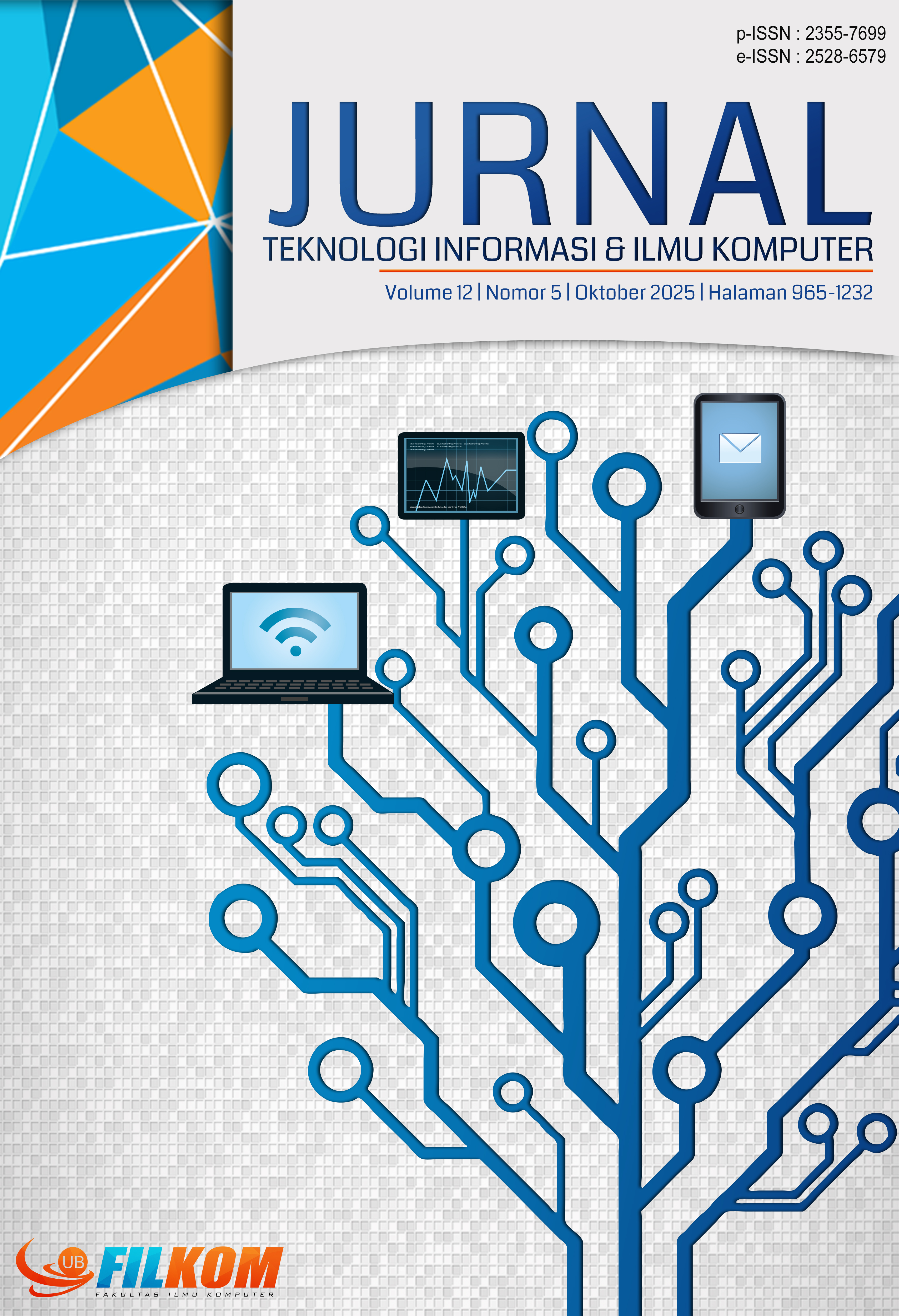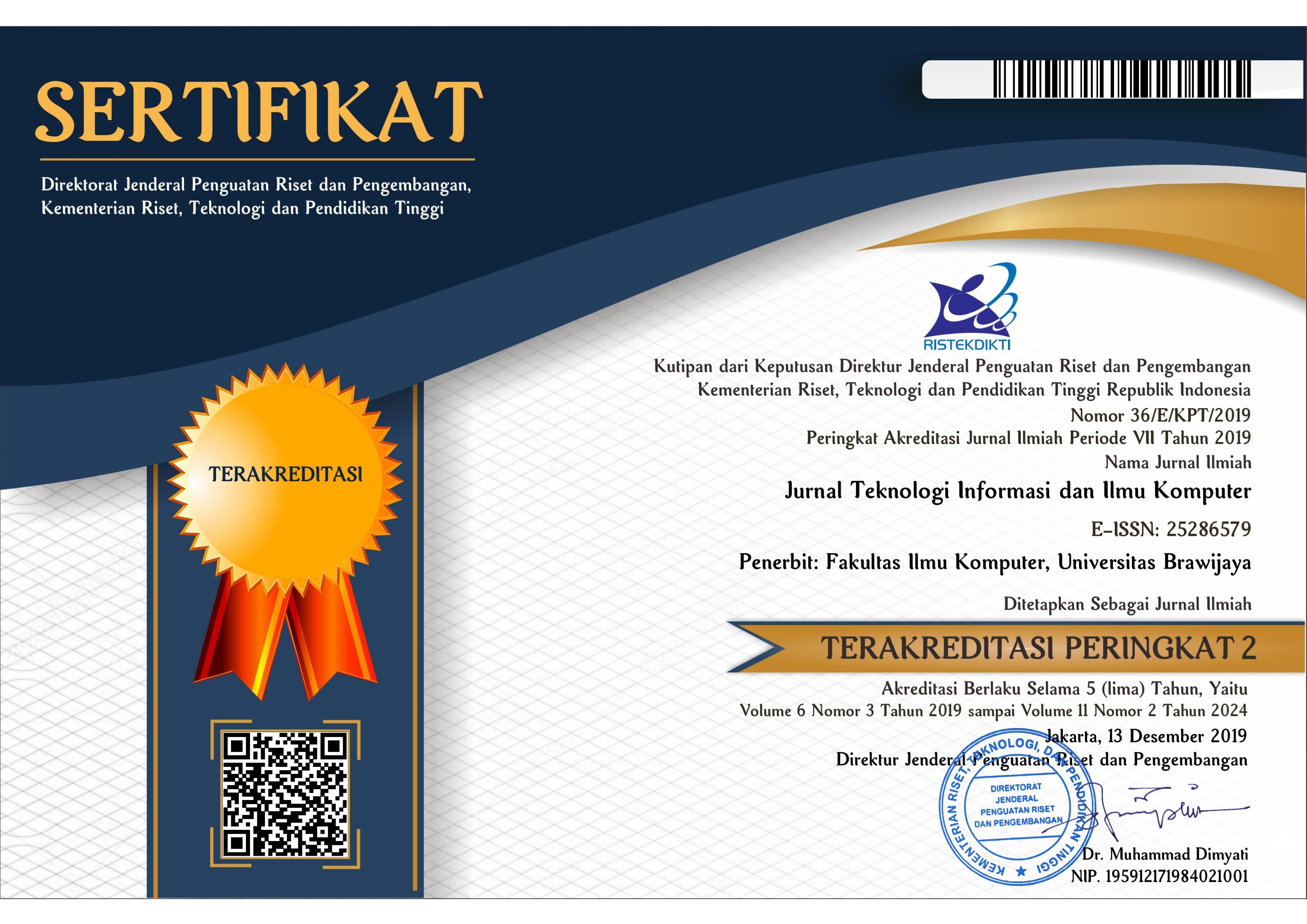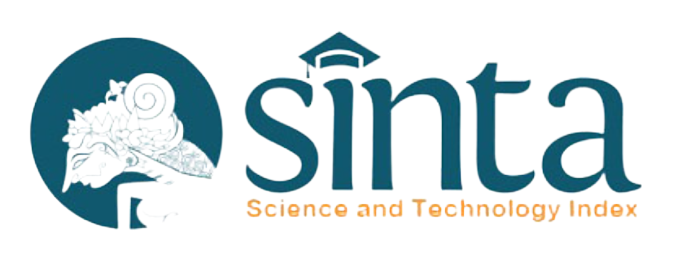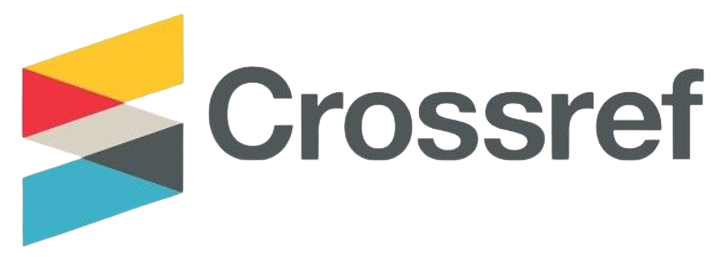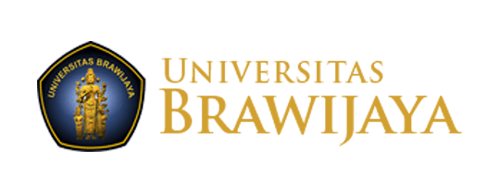Model Hibrida CNN Berbobot dan Model Adaboost Decision Tree untuk Klasifikasi Penyakit Kubis pada Dataset Tidak Seimbang
DOI:
https://doi.org/10.25126/jtiik.2025125Kata Kunci:
AdaBoost, Cabbage, CNN, decision tree, Imbalanced DataAbstrak
Metode klasifikasi berbasis gambar banyak digunakan dalam bidang pertanian untuk mendeteksi penyakit pada berbagai tanaman, termasuk jenis yang rentan terhadap infeksi seperti kubis. Namun, performa optimal dalam klasifikasi gambar sangat dipengaruhi oleh jumlah dan keseimbangan data. Ketidakseimbangan data dalam klasifikasi penyakit tanaman kubis dapat menyebabkan model lebih memfokuskan perhatian pada kelas mayoritas, sehingga mengabaikan kelas minoritas, terutama pada klasifikasi multi-kelas. CNN sering digunakan dalam klasifikasi gambar, tetapi memiliki kelemahan dalam menangani data tidak seimbang karena cenderung lebih fokus pada kelas mayoritas. Untuk mengatasi permasalahan ini, dikembangkan model Hybrid yang mengombinasikan metode pembobotan pada CNN untuk ekstraksi fitur, model estimasi menggunakan Decision Tree, serta teknik ensemble Adaboost pada tahap klasifikasi. Pendekatan ini dirancang untuk meningkatkan kemampuan generalisasi terhadap kelas minoritas serta menghasilkan distribusi prediksi yang lebih seimbang. Hasil penelitian menunjukkan bahwa model Hybrid yang diusulkan mampu meningkatkan performa klasifikasi sebagaimana terlihat dari peningkatan Weighted Average F1-score menjadi 97%, dibandingkan model CNN tunggal dengan pembobotan yang hanya mencapai 63%. Peningkatan ini menunjukkan bahwa model Hybrid tidak hanya lebih efektif dalam menangani ketidakseimbangan data, tetapi juga mampu melakukan generalisasi yang lebih baik.
Abstract
Image-based classification methods are widely used in agriculture to detect diseases in various plants, including those susceptible to infections, such as cabbage. However, achieving optimal performance in image classification is highly influenced by the quantity and balance of the data. Data imbalance in cabbage disease classification can cause the model to focus more on the majority class while neglecting the minority class, especially in multi-class classification. CNN is commonly used for image classification but struggles with imbalanced data, as it tends to prioritize the majority class. To address this issue, a hybrid model has been developed by combining weighting techniques in CNN for feature extraction, a Decision Tree for estimation, and the Adaboost ensemble technique for classification. This approach is designed to enhance generalization for minority classes and produce a more balanced prediction distribution. The results of the study indicate that the proposed Hybrid model is capable of improving classification performance, as evidenced by an increase in the Weighted Average F1-score to 97%, compared to the weighted CNN model, which achieved only 63%. This improvement demonstrates that the Hybrid model is not only more effective in addressing data imbalance but also better at generalizing the data.
Downloads
Referensi
ALMARSHDI, R., NASSEF, L., FADEL, E., ALOWIDI, N., 2023. Hybrid Deep Learning Based Attack Detection for Imbalanced Data Classification. Intell. Autom. Soft Comput. 35, pp.297–320.
ALZAMMAM, A., BINSALLEEH, H., ASSADHAN, B., KYRIAKOPOULOS, K.G., LAMBOTHARAN, S., 2020. Comparative analysis on imbalanced multi-class classification for malware samples using CNN. 2019 Int. Conf. Adv. Emerg. Comput. Technol. AECT 2019, pp.1–6.
ANDRIYANTO, R., 2024. Enhancing Sentiment Analysis Effectiveness with LSTM Variants , and Stratified K-Fold on Imbalanced Dataset 6, pp.981–990.
BHUTADA, S., YASHWANTH, N., DHEERAJ, P., SHEKAR, K., 2022. Opening and closing in morphological image processing. World J. Adv. Res. Rev. 14, pp.687–695.
BYEON, H., 2021. Comparing the Balanced Accuracy of Deep Neural Network and Machine Learning for Predicting the Depressive Disorder of Multicultural Youth. Int. J. Adv. Comput. Sci. Appl. 12, pp.584–588.
CHABALALA, Y., ADAM, E., ALI, K.A., 2023. Exploring the Effect of Balanced and Imbalanced Multi-Class Distribution Data and Sampling Techniques on Fruit-Tree Crop Classification Using Different Machine Learning Classifiers. Geomatics 3, pp.70–92.
DABLAIN, D., JACOBSON, K.N., BELLINGER, C., ROBERTS, M., CHAWLA, N. V, 2023. Understanding CNN Fragility When Learning With Imbalanced Data. Mach. Learn. pp.1–26.
EL SAKKA, M., IVANOVICI, M., CHAARI, L., MOTHE, J., 2024. A Review of CNN Applications in Smart Agriculture Using Multimodal Data.
GRANDINI, M., BAGLI, E., VISANI, G., 2020. Metrics for Multi-Class Classification: an Overview. pp.1–17.
JIANG, L., YUAN, B., MA, W., WANG, Y., 2023. JujubeNet: A high-precision lightweight jujube surface defect classification network with an attention mechanism. Front. Plant Sci. 13, pp.1–16.
JIJO, B.T., ABDULAZEEZ, A.M., 2021. Classification Based on Decision Tree Algorithm for Machine Learning. J. Appl. Sci. Technol. Trends 2, pp.20–28.
LIU, Z., MAO, H., CHRISTOPH, C.W., TREVOR, F., SAINING, D., BERKELEY, U.C., WU, C.-Y., FEICHTENHOFER, C., DARRELL, T., XIE, S., 2022. [ConvNeXt_CVPR22] A ConvNet for the 2020s. Cvpr 11976–11986.
LOTUFO, R.A., AUDIGIER, R., SAÚDE, A. V, MACHADO, R.C., 2023. Chapter Six - Morphological Image Processing, in: Merchant, F.A., Castleman, K.R. (Eds.), Microscope Image Processing (Second Edition). Academic Press, pp. 75–117.
MIENYE, I.D., SUN, Y., 2022. A Survey of Ensemble Learning: Concepts, Algorithms, Applications, and Prospects. IEEE Access 10, pp.99129–99149.
MYNA, A.N., K., M., K., M., S., R.H., JAIN, Y.D., 2023. Classification and Detection of Cabbage Leaf Diseases from Images Using Deep Learning Methods. Autom. Control Intell. Syst. 11, pp.1–7.
REYA, S.S., MALEK, M.D.A., DEBNATH, A., 2022. Deep Learning Approaches for Cabbage Disease Classification, in: 2022 International Conference on Recent Progresses in Science, Engineering and Technology (ICRPSET). pp. 1–5.
ROKHANA, R., HERULAMBANG, W., INDRASWARI, R., 2022. Classification of Ocular Diseases on Fundus Images Using Weighted MobileNetV2. IES 2022 - 2022 Int. Electron. Symp. Energy Dev. Clim. Chang. Solut. Clean Energy Transition, Proceeding pp.570–575.
SATHIYAPRIYA, G., SHANTHI, S.A., 2022. Image Classification using Convolutional Neural Network. 2022 1st Int. Conf. Electr. Electron. Inf. Commun. Technol. ICEEICT 2022, pp.6867–6884.
SHARMA, R., BRAR, M., 2024. Agricultural Informatics: Assessing CNN and Decision Tree Effectiveness in Indian French Bean Variety Classification. 2024 4th Int. Conf. Intell. Technol. CONIT 2024, pp.1–5.
SHARP, B., ROMANIUK, J., GRAHAM, C., 2019. Marketing’s 60/20 Pareto Law. SSRN Electron. J.
TAHERKHANI, A., COSMA, G., MCGINNITY, T.M., 2020. AdaBoost-CNN: An adaptive boosting algorithm for convolutional neural networks to classify multi-class imbalanced datasets using transfer learning. Neurocomputing 404, pp.351–366.
TODI, A., NARULA, N., SHARMA, M., GUPTA, U., 2023. ConvNext: A Contemporary Architecture for Convolutional Neural Networks for Image Classification. Proc. - 2023 3rd Int. Conf. Innov. Sustain. Comput. Technol. CISCT 2023.
WU, Y., KE, Y., CHEN, Z., LIANG, S., ZHAO, H., HONG, H., 2020. Application of alternating decision tree with AdaBoost and bagging ensembles for landslide susceptibility mapping. Catena 187, 104396.
Unduhan
Diterbitkan
Terbitan
Bagian
Lisensi
Hak Cipta (c) 2025 Jurnal Teknologi Informasi dan Ilmu Komputer

Artikel ini berlisensiCreative Commons Attribution-ShareAlike 4.0 International License.

Artikel ini berlisensi Creative Common Attribution-ShareAlike 4.0 International (CC BY-SA 4.0)
Penulis yang menerbitkan di jurnal ini menyetujui ketentuan berikut:
- Penulis menyimpan hak cipta dan memberikan jurnal hak penerbitan pertama naskah secara simultan dengan lisensi di bawah Creative Common Attribution-ShareAlike 4.0 International (CC BY-SA 4.0) yang mengizinkan orang lain untuk berbagi pekerjaan dengan sebuah pernyataan kepenulisan pekerjaan dan penerbitan awal di jurnal ini.
- Penulis bisa memasukkan ke dalam penyusunan kontraktual tambahan terpisah untuk distribusi non ekslusif versi kaya terbitan jurnal (contoh: mempostingnya ke repositori institusional atau menerbitkannya dalam sebuah buku), dengan pengakuan penerbitan awalnya di jurnal ini.
- Penulis diizinkan dan didorong untuk mem-posting karya mereka online (contoh: di repositori institusional atau di website mereka) sebelum dan selama proses penyerahan, karena dapat mengarahkan ke pertukaran produktif, seperti halnya sitiran yang lebih awal dan lebih hebat dari karya yang diterbitkan. (Lihat Efek Akses Terbuka).

